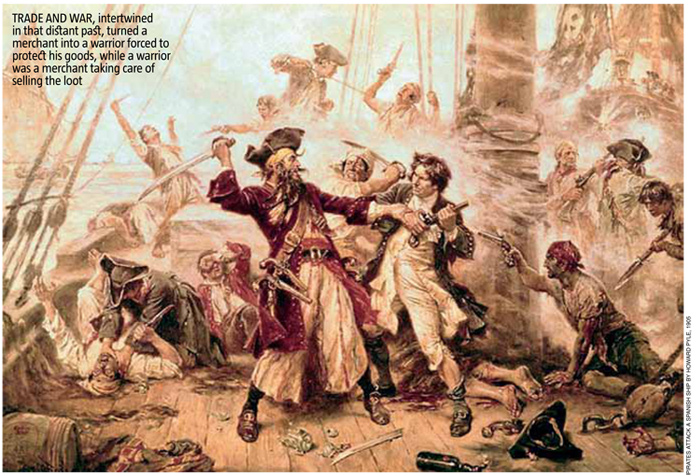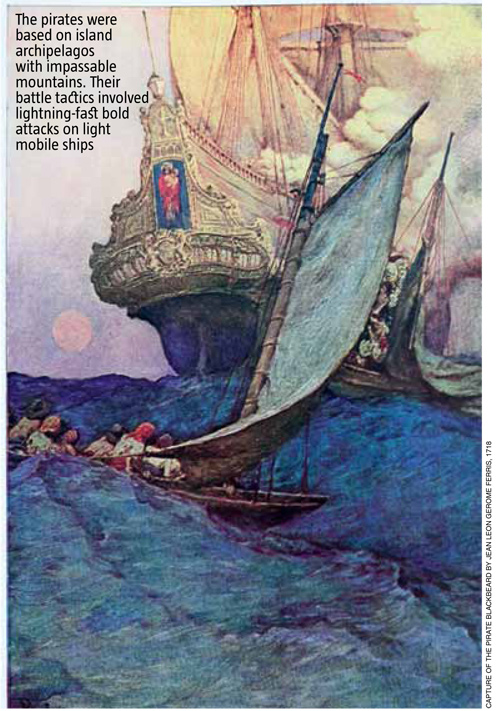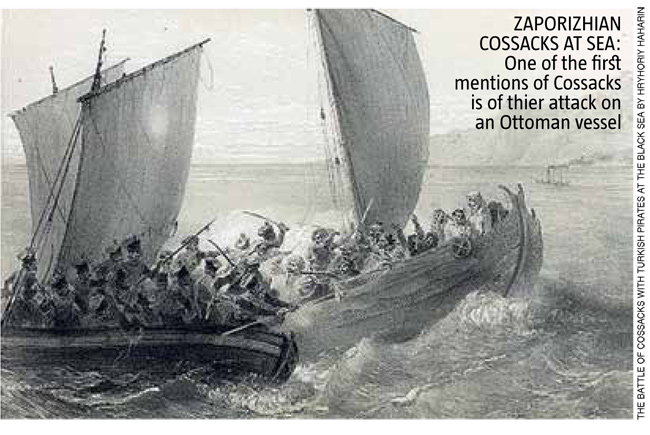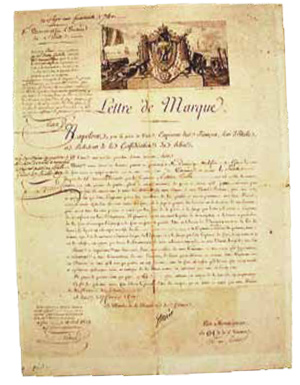Piracy seems to have lost its historic menacing status, turning into an adventure story for kids in the contemporary world. Yet, the ever more frequent pirate attacks in water and air indicate the opposite. This reincarnation comes from the social nature and roots of piracy, a phenomenon that is over three thousand years old.
AT THE DAWN OF CIVILIZATION
Pirates were the main characters in one of the first pieces of literature ever written. Certainly, Homer sent Odysseus and his good guys on noble exploits rather than robberies. Yet, their likeliest prototypes were Greek colonists sailing across the Mediterranean in search of a better life. Interestingly, the word “pirate”, pirata in Latin, comes from the Greek πειράω – to test. Trade and war, intertwined in that distant past, turned a merchant into a warrior forced to protect his goods, while a warrior was a merchant taking care of selling the loot.
By the early 1st century, the Peloponnese no longer had enough natural resources to feed their growing population, sending the Greeks exploring and settling in new lands beyond their small Greece. The great colonization movement that covered the entire Mediterranean, later spreading to the Black Sea and the Sea of Azov, was far from peaceful, accompanied by clashes with Barbarians and those between colonists. As soon as the newly-built colony cities started churning windfall profits from transit trade in deficit goods, slaves and food, they immediately fell under the control of sea bandits who controlled sea routes.

Piracy soon swelled and developed its internal structure and specialization. Some of its features are present to this day. The pirates were based on island archipelagos with impassable mountains. Their battle tactics involved lightning-fast bold attacks on light mobile ships.
Reluctant to cast the shadow of infamy on his compatriots, Homer mostly talks about Phoenician pirates, the Greeks’ neighbours, although Greek pirates were equally notorious. They were only crushed in the 5th century BC. Black Sea piracy, remote from the hearts of the ancient civilization, not only fed on well-off merchant towns but acted as the military ally of local rulers. Mithridates VI of Pontes (121-63 years BC) made a deal with several pirate gangs to loot the cities and fleets of ancient Rome.
MASTERS OF THE SEAS AND OCEANS
Overall, the history of piracy leans towards Europe, although it reached much farther than that. Sea raids always flourished alongside economic and trade growth and complicated society structures. A classic example are the Wokou, Japanese and Taiwanese pirates that raided the Southern Chinese and Korean coasts in the 9th-16th centuries. Asian pirate fleets were made up of impoverished fishermen, craftsmen and dropout samurais. They raided wealthy cities and merchant ships, occasionally taking regular tributes from fishing villages.
READ ALSO: Piracy at Sea Has Real Impact on Ukraine
Another notable example of piracy were the Vikings. A mix of Northern peoples from poor countries, the Vikings raided the coastlines of Europe, Anatolia and North Africa. The lack of stable and well-governed states in the early medieval Old World made them convenient and extremely vulnerable to Viking raids. They started off with the coastline and gradually moved deeper into the continent via rivers. However, this piracy was not all about primitive robbery. As Viking chieftains levied regular tributes in some areas, they gradually organized permanent garrisons, laws and judiciaries there. The first dynasties of Varangians – the name given to them by the Greeks and Eastern, emerged from them. Some of them eventually became the rulers of great states, such as Kyiv (Kievan) Rus. The echo of Norman exploits was still heard in the late Middle Ages, when Europe was on the verge of the Age of Exploration: several gangs from Friesland, i.e. Scandinavian and Dutch, pirates led by Pier Gerlofs Donia best known as Grutte Pier or Big Pier, successfully fought against Emperor Charles V, seizing 28 vessels.

European pirates were not only of English, Spanish or French descent as we commonly think, inspired by pirate adventure novels. Mauritanian pirates – mostly Arabs and Berbers based in Crete and the Balearic Islands – were equally bold and violent, most often raiding Rome (they even looted the Vatican in 911) and the Republic of Venice. With their control over virtually the entire Western Mediterranean, Barbary corsairs dominated the area until as late as the 19th century. The key to their success was the political protectorate of Middle Eastern countries, including the Ottoman Empire, to which pirates supplied slaves. According to various estimates, they sold between 1 and 1.25mn slaves from the 16th to the 19th centuries. At the same time, Barbary pirates were also a kind of shield against fleets from Christian countries.
The Slavs did not lag far behind in the piracy business. Illyrian robbers, who settled in the cozy bays of what is now Montenegro and Dalmatia, often plagued Italian cities since the 9th century. Later, these pirates turned not only into the worst enemies of Italian merchants, but a menace to Dubrovnik as the biggest trading city. In the late 11th century, a Slavonic version of the Vikings, called the ushkuiniks (from Russian oskui, ushkui – a type of flat-bottom medieval Finnish river vessel) emerged in Northern Rus. Armed squadrons of ushkuiniks, enjoying the financial patronage of Novgorod boyars and merchants, initially robbed and traded on the Volga and Kama rivers. They later went on to raid Northern Sweden and Finland. In the 14th century, ushkuinik expeditions reached as far as Western Siberia and were a serious threat to ambitious Moscow rulers.
THE GOLDEN AGE
The image of a pirate from novels and movies is a collective portrait of sea bandits from the Golden Age of 1500-1750, the era following the discovery of colonies and the stabilization of sea routes that opened the door to transoceanic piracy. Since then, piracy had become omnipresent, multinational and probably the most vivid and flamboyant cultural phenomenon. However, its economic and social essence has barely changed. Initially, the key purpose of sea piracy was to gain expensive colonial goods, including precious metals and slaves – and to a lesser extent – spices, cotton, rubber, ebony and drugs. Later, the purpose changed to robbery or the taxation of coastal cities, trading colonies, industrial factory and plantation owners. The Caribbean Basin became the intersection of pirate communications, where the controversies and conflicts of rival European states regarding the expansion of their borders and trade were intertwined.
Economically, sea robbery was indeed worth the risk. The biggest trophies – seized vessels and cargos, not counting ransoms for crew and passengers – could reach GBP 16,000 to 150,000, enormous wealth in the 17-18th centuries. So it’s no wonder that gentlemen of fortune never switched to peaceful work, such as hunting or farming, which the Caribbean pirates tried to practice in Haiti.

However, not everyone could manage their money well. It is known for a fact that only several pirates had modest real estate and even fewer invested in trade expeditions after leaving their risky business. Moreover, running any business required support from at least some form of government, thus relative legitimacy. When the notorious English pirate, Edward Teach, better known as Blackbeard, seized a big cargo of sugar and cocoa beans in 1718, he could only gain from his trophy after sharing it with the governor of North Carolina. Legends of pirates’ treasure, freely written about by novelists, were in fact an element of pirate folklore, where a good catch was the attribute of a lucky captain, which he had to share generously with his team.
We don’t know much about the real everyday life of sea bandits: most of the information we have comes from official documents, court verdicts and investigation records. Thus, modern knowledge of even the most well-known pirate captains is chaotic, and interspersed with stories made up by 18th century writers, who were the first to mould the infernal image of pirates. According to historians, there were up to 40,000 pirates in the Atlantic between the 16th and 17th centuries. Most were sailors or regular boys under the age of 25 from port cities and fishing villages.
COSSACK PIRATES
Sea raids were common in the Black Sea as well. Evidently, the Rus people had been joining multiethnic Black Sea gangs since the times of the princes. They later passed on the baton to Ukrainian Cossacks.
Of all the knights of the steppes, the Zaporizhian Cossacks were the most prone to sea exploits: the locations they chose to settle in and the traditional activities that included semi-nomadic cattle breeding and expeditions to the steppes to hunt, fish and gather honey, fit in with archaic economic models where trade and robbery walked hand in hand. One of the first mentions of Cossacks dates back to their raid of a Turkish vessel in 1492. In subsequent centuries, Cossacks sailed far beyond the Dnipro and Dniester, to the most remote corners of the Black Sea coast, including Istanbul, the capital of the Ottoman Empire.
For the Polish-Lithuanian Commonwealth, Cossack raids on Turkish fortresses and cities were an analogue of a privateer war, used as convenient tools for blackmailing the Ottoman Empire in diplomatic negotiations. Cossacks did not hide their motivation, which was more about rich trophies than patriotic goals of freeing slaves and protecting their country.
PIRATES IN LAW
Piracy was recognized as a criminal activity and social disease back in ancient times. The first large expedition against pirates was sent from the Roman Empire in the 1st century BC. It involved 500 vessels. Coastguards emerged in Europe in the late Middle Ages, and later in its colonies. They worked on the sea and on land, catching smugglers, vagrants and bandits. Maritime laws were established at the same time. As the military techniques and economic components of wars developed, monarchs realized that illegal maritime exploits could become legal if they served the interests of a state rather than those of bandit gangs. This saw the emergence of privateers – pirate entrepreneurship, organized and protected by legitimate governments during wars. It was based on the then legal concepts of the “right to attack all enemies of a kingdom during a war” and the “right to revenge by robbing enemies”. Privateers had special licenses guaranteeing the legitimacy of their actions, as well as the support of civilian and military authorities. Pirates in law were either former pirates seeking a pardon, or adventurous merchants hoping to improve their situation during a war.

Letter of Marque and Reprisal, a government license making the actions of privateers legitimate
Privateering has always been controversial in international law and public opinion. Possibly the best-known example of the reinterpretation of privateering as a war crime was the CSS Alabama, which was constructed by the Southern States in the United Kingdom and manned with an international crew during the American Civil War. By seizing and sinking 69 vessels of the Northern States in the Atlantic and Indian Oceans in 1862-1864, it essentially paralyzed the North’s international trade and passenger traffic. This privateering campaign was reinterpreted as a war crime.
TO BE CONTINUED?
Grey zones, i.e. sea and ocean areas under the weak control of respective jurisdictions, are the most common environments for piracy. It was there that raids took place, trophies were shared and nautical Robin Hoods found shelter. The farther the presence of legitimate governments extended, the fewer the chances of survival. In the early 19th century, coastal governments joined the efforts to oust then eliminate piracy in the Caribbean and the Atlantic. Great Britain was particularly uncompromising in the anti-piracy campaign, putting piracy on a par with slave trafficking and declaring it to be mutually-related to international crimes. This made persecution more consistent and crushed economic grounds for the revival of privateering. Advancing war technologies, such as steam fleets, on-board deck artillery and new navigation and reconnaissance systems that were largely accessible to navies, deprived pirates of the chance to resist in this long-term conflict. In the late 19th century, what piracy remained was crashed in the most remote corners of the Indian and Pacific Oceans where its rudiments survived the longest.
However, hopes of peace were futile. Piracy is becoming reincarnated in modern times, although it is completely different from what it was in the past. Today, cruisers equipped with sophisticated satellite navigation, modern weapons, own networks of agents, legal and financial intermediaries make their “business” a major threat to the security of the globalized world. The UN now conducts anti-piracy training almost every year, often involving the Ukrainian navy. However, while struggling with the consequences, it is necessary to remember the cause of the problem: criminal business always goes hand-in-hand with the poverty and military conflicts that torment the “peripheral” regions of the civilized world.
INTERESTING FACTS IN THE HISTORY OF PIRACY
75 BC — Cilicia pirates kidnap Julius Caesar
642 — Illyria pirates start regular raids on Italy
789 — the Vikings attack South-Western England for the first time
1318 — Novgorod Ushkuiniks plunder the city of Abo in Finland
1523 — pirates seize Spanish vessels carrying Aztec treasures
1615 — the Zaporizhian fleet raids Istanbul
1631 — Barbary pirates raid Baltimore
1671 — Henry Morgan’s pirates attack Panama
1762 — pirates seize HMS Hermione, setting a record in the history of piracy
1804 — Chinese pirates establish a coalition
1812 — Jean Lafitte’s pirates fight in the Battle of New Orleans as part of the American army
1848 — the Spanish fleet crushes Muslim pirates off the coast of the Philippines
INFO
Pirate slang, a mix of English, Spanish and Indian languages, left a legacy of words that are often used today, including hurricane, hammock and canoe
The Jolly Roger, a black pirate flag with a skull and crossed thigh bones (crossbones) or knives was not the only version of the flag. It came into use relatively late, sometime on the verge of the 17th and 18th centuries. More commonly, pirates used red flags, indicating high alarm and threat in the language of naval symbols. Images on the flags varied from the patron saints of the vessels to Cabbala symbols.
AMAZONS OF THE SEA
Ships were not a place for women, but pirates obviously had their own opinions on this. The most famous female pirates that left their mark on history were Mary Read (1685-1721) and Anne Bonny (1700-1782). Mary spent a large part of her career dressed as a man. Anne was famous for charming the battle-seasoned pirate captain John Rackham, commonly known as “Calico Jack”. Eventually, all three ended up on one ship. Chinese-born Ching Shih (1785-1844) was another prominent female pirate who commanded a highly disciplined fleet of over 80,000 Asian pirates

